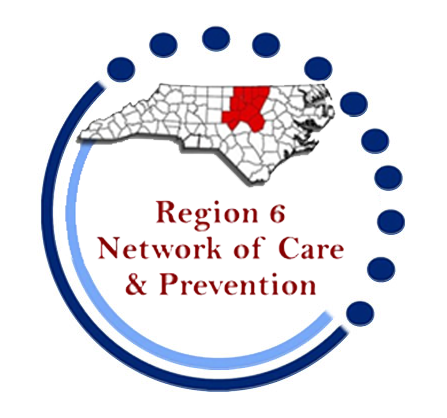Mission
The mission of the Region VI Network of Care and Prevention is to promote a coordinated effort between regional HIV, STI, and HCV care, treatment and prevention partners that works collaboratively to reduce the number of new HIV infections, decrease disparities in care, and optimize health outcomes for people living with HIV/AIDS (PLWHA).
Purpose
- The Network will increase the amount of HIV, STI, and HCV testing done among high-risk populations across the region, link individuals newly diagnosed quickly into care, and keep clients in care and virally suppressed in order to reduce new infections and reduce transmission of HIV.
- The Network will assist the State of North Carolina Department of Health and Human Services (DHHS) to provide HIV/AIDS care and prevention programing utilizing a regional approach that brings together the contributions of local government and community-based organizations (CBO), consistent with the National HIV/AIDS Strategy.
History
The genesis of the Region 6 Network of Care and Prevention (aka: Network) began in the spring of 2008. Facilitated by Piedmont Consortium, the local community of providers worked over the course of 18 months to establish the structure and the focus of what would become the Network. The group assembled submitted an application to the AIDS Care Program (ACP) in September of 2008. The application was accepted, and implementation began in April 2009
Since that time, the Network has been diligent in its continuous attempts to include as many stake-holders, clients, service providers, etc. as possible. As a result, participation in Network activities is robust and, typically, involves approximately two dozen agencies at any given point in time. The Network is incredibly proud of the partnerships that have been assembled because of the Patient Management Model. The various Network partners, both Part B funded and non-funded, as well as prevention agencies that provide education and HIV/STD testing. We have utilized the Network as a catalyst for establishing linkages, service coordination, referral sources, and sources for new patient identification, and, as such, the system of care across the region is a rich tapestry firmly stitched together by an overarching sense of cooperation, collaboration, and client-centered service delivery.
In 2014, spurred by an open RFA process with the state of North Carolina’s AIDS Care Program, the Network engaged in a number of exercises to prepare itself for both reflection of its current state and for planning for its future. Identifying viral suppression as the ultimate goal of a successful HIV strategy, the Network collectively mapped the steps and services that must be in place from an untested, undiagnosed person through viral suppression beginning with Prevention Services (i.e. HIV/STD Counseling and Testing and PrEP) and continuing through to Care services for those who are identified as positive to achieve and maintain viral suppression. Overlaying these steps were complimentary services such as housing, food, dental care, translation services, health literacy services, etc. In the Network’s opinion, those services were not necessarily ones that created viral suppression in an individual; however, the absence of those services for the clients who need them, especially when the need for those services is as acute as any medical need, creates barriers that can, in fact, lead to non-suppression of viral load.
The Network has maintained an earnest effort for full and maximum inclusion of all providers across its eleven counties. Participation in both the Network and in this process is open to any agency desirous of inclusion. No program that expresses a desire to be a part of the Network has been excluded. Naturally, some providers have demonstrated a greater opportunity or desire to participate in the Network process than have others. We are encouraged by the progress we have made in identifying individuals positive for HIV/STDs and getting them quickly into treatment. We are also excited to have recently received funding to promote the uptake of Pre-Exposure Prophylaxis (PrEP) for high risk HIV negative individuals.
